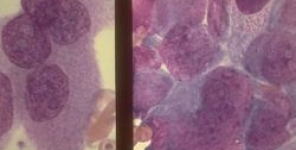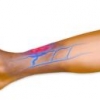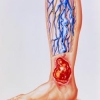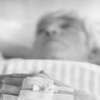L'idrogel a base di poliacrilato modulante le proteasi stimola la preparazione del letto della ferita nelle ulcere venose degli arti inferiori
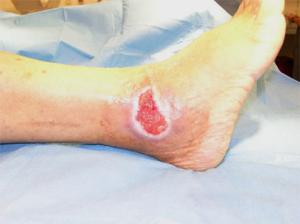 Uno studio controllato e randomizzato.
Uno studio controllato e randomizzato.
Il controllo rigoroso dell'attività proteolitica rappresenta il più importante approccio terapeutico per la preparazione del letto delle ferite.
Obiettivi
Abbiamo voluto testato se un idrogel contenente poliacrilato (PA) modulante le proteasi determini una più efficiente preparazione del letto della ferita nelle ulcere venose rispetto ad un idrogel amorfo senza note proprietà modulanti le proteasi.
Metodi
I pazienti sono stati randomizzati per ricevere l'idrogel a base di poliacrilato (n = 34 ) o un idrogel amorfo (n = 41). Tre esperti in cieco hanno valutato i letti delle ferite utilizzando le fotografie scattate nei giorni 0, 7 e 14.
Risultati
Dopo 14 giorni di trattamento c'è stato un calo assoluto della fibrina e del tessuto necrotico di 37.6 ± 29.9 punti percentuali nel gruppo con idrogel a base di PA e di 16.8 ± 23.0 punti percentuali nel gruppo con idrogel amorfo. L'aumento assoluto della porzione di superficie dell'ulcera coperta da tessuto di granulazione è stato di 36.0 ± 27.4 punti percentuali nel gruppo con idrogel a base di PA e di 14.5 ± 22.0 punti percentuali nel gruppo di controllo. Pertanto, le differenze tra i gruppi sono state significative (diminuzione della fibrina e del tessuto necrotico P = 0.004 ed aumento di tessuto di granulazione P = 0.0005, rispettivamente).
Conclusione
Sono state soprattutto le ferite di lunga data ad aver beneficiato del trattamento con idrogel a base di PA. Questi dati suggeriscono che le medicazioni con idrogel a base di PA possono stimolare la normalizzazione dell'ambiente della ferita, in particolare per quanto riguarda le ulcere di difficile guarigione.
Storia della pubblicazione:
Titolo: Protease-modulating polyacrylate-based hydrogel stimulates wound bed preparation in venous leg ulcers — a randomized controlled trial
Rivista: Journal of the European Academy of Dermatology and Venereology. doi: 10.1111/jdv.12400
Autori: P. Humbert, B. Faivre, Y. Véran, C. Debure, F. Truchetet, P.-A. Bécherel, P. Plantin, J.-C. Kerihuel, S.A. Eming, J. Dissemond, G. Weyandt, D. Kaspar, H. Smola, P. Zöllner, On behalf of the CLEANSITE study group
Affiliazioni:Research and Studies Center on the Integument (CERT), Clinical Investigation Center (CIC BT), Department of Dermatology, University Hospital, Besançon, France INSERM UMR, University of Franche-Comté, Besançon, France Department of Dermatology, University Hospital, Besançon, France Department of Dermatology, Hôpital d'Instructions des Armées A. Legouest, Metz, France Cardio-Vascular Rehabilitation Unit, Hôpital Corentin Cellon, Issy les Moulineau, France Department of Dermatology, Hôpital Beauregard, Thionville, France Department of Dermatology, Hôpital Privé d'Antony, Antony, France Department of Dermatology, Centre Hospitalier Laennec, Quimper, France Vertical, Paris, France Department of Dermatology, University of Cologne, Cologne, Germany Department of Dermatology, University Hospital Essen, Essen, Germany Department of Dermatology, University of Würzburg, Würzburg, Germany Paul Hartmann AG, Heidenheim, Germany
Abstract:
Background Stringent control of proteolytic activity represents a major therapeutic approach for wound-bed preparation. Objectives We tested whether a protease- modulating polyacrylate- (PA-) containing hydrogel resulted in a more efficient wound-bed preparation of venous leg ulcers when compared to an amorphous hydrogel without known protease-modulating properties. Methods Patients were randomized to the polyacrylate-based hydrogel (n = 34) or to an amorphous hydrogel (n = 41). Wound beds were evaluated by three blinded experts using photographs taken on days 0, 7 and 14. Results After 14 days of treatment there was an absolute decrease in fibrin and necrotic tissue of 37.6 ± 29.9 percentage points in the PA-based hydrogel group and by 16.8 ± 23.0 percentage points in the amorphous hydrogel group. The absolute increase in the proportion of ulcer area covered by granulation tissue was 36.0 ± 27.4 percentage points in the PA-based hydrogel group and 14.5 ± 22.0 percentage points in the control group. The differences between the groups were significant (decrease in fibrin and necrotic tissue P = 0.004 and increase in granulation tissue P = 0.0005, respectively). Conclusion In particular, long-standing wounds profited from the treatment with the PA-based hydrogel. These data suggest that PA-based hydrogel dressings can stimulate normalization of the wound environment, particularly in hard-to-heal ulcers.
